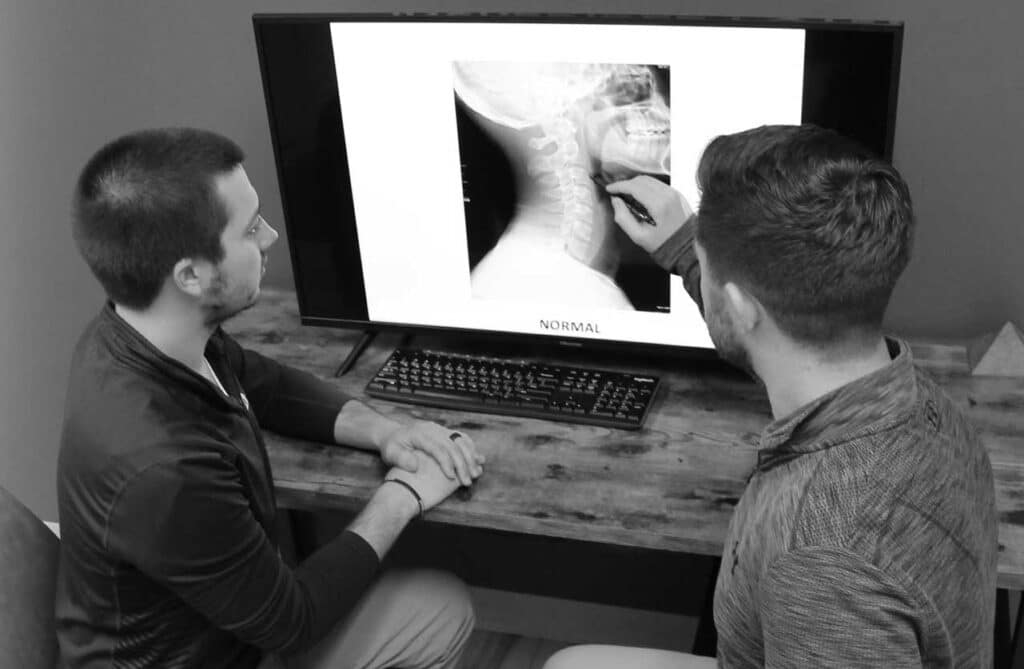
Chiropractic Care For Neck Pain
Neck pain is a common problem that can significantly affect your daily activities. However, many people need to be aware of the effective treatments offered by chiropractors specializing in neck issues. We provide comprehensive care for individuals suffering from neck problems at Advantage Chiropractic in New Berlin, Wisconsin. Our chiropractors are highly experienced, board-certified by the state of Wisconsin, and trained in the Torque Release Technique (TRT), a highly effective method for treating cervical pain.
The appropriate treatment for neck strain and pain depends on the underlying cause. However, there are steps to improve your quality of life.
If you are suffering from neck issues, seeking the assistance of a chiropractor can be a great way to find relief and address any related problems. You don’t have to let neck pain hold you back any longer. Taking charge of your health and benefiting from chiropractic care can help you feel better and improve your overall quality of life.
Our Neck Pain Chiropractors in New Berlin, WI

Dr. Evan Norum
BOARD CERTIFIED IN CHIROPRACTORS

Dr. Taylor Moore
BOARD CERTIFIED CHIROPRACTORS
Trustindex verifies that the original source of the review is Google. I really think Dr. Evans and Dr. Taylor are wonderful at what they do! During my first appointment, Melissa made me feel at ease while she asked a few questions and took my x-rays. Dr. Evans then went through my x-rays with me and explained everything really well, which I appreciated so much. I’ve also seen Dr. Taylor a couple of times for adjustments, and he’s always been so professional and friendly! The only downside is that their practice is a bit far from my home, making it tough for me to go regularly right now. But I definitely recommend them to anyone looking for great care!Trustindex verifies that the original source of the review is Google. Highly recommended, very professionalTrustindex verifies that the original source of the review is Google. Doctors r very knowledgeable about how body works n do everything to keep me in good health. Always ask me if i have any questions they can answer. Gal in front office r friendly n professional. Great place to go for Chiropractic help as well as Neuropathy concerns!! 😊💖Trustindex verifies that the original source of the review is Google. I have been receiving services at Advantage Chiropractic for a while now. I am getting more comfortable with the process. The services have been helpful and have made a difference. The Chiropractors and staff members are always pleasant, which is a plus.Trustindex verifies that the original source of the review is Google. I didn't realize how out of whack by shoulders and back had become thru years of sports, sport related injuries and simply by being older. After a few months of careful attention by the doctors and staff, I steadily gained back flexibility and most importantly decreased the level of pain and soreness in my joints. I wish when I was younger, we didn't just rub dirt on it, but instead had some intelligent therapy to treat injuries and bounce back better.Trustindex verifies that the original source of the review is Google. Everyone in the office is so professional and friendly. If you need to change an appointment, or have a specific area of pain to address, the 3 office staff ladies or the 2 friendly, knowledgeable chiropractors will listen, and do their best to help you. I HIGHLY RECOMMEND this chiropractor as someone who can help with body pain including neuropathy. As someone who has been described as a complex case of neuropathy to solve, I have gladly welcomed them to my team.Trustindex verifies that the original source of the review is Google. I’ve been going to Advantage Chiropractic for about 3 months now and the change in my health and body is awesome! I can now sleep well, I have less stomach issues and no longer have excruciating pain/discomfort in my shoulder. I was a bit skeptical starting out but these adjustments are obviously working. The staff is so nice and organized. I recommend anyone who prioritizes their health to visit and get a free consultation as soon as possible. Thank you Advantage Chiropractic!!!Trustindex verifies that the original source of the review is Google. Hello reviewer, I saw a commercial that emphasized non-surgical help with issues I've been experiencing the past couple of years. I went in for an evaluation/assessment with x-rays and a gadget to measure nerve damage, and only paid $49.00 for that exam. I found out I had nerve damage in both of my lower legs and feet. We discussed a plan, and I felt hopeful. My health insurance paid about one third of the cost for this particular plan, and I paid out-of-pocket for the balance. They do have a partnership with a health care financial center (i.e., requires a hard credit check) that will finance the balance with 0% interest which was helpful. I've been getting neuropathy therapy since September, and my feet are feeling better with less pain. I sleep better, and fall asleep easier and quicker, and sleep throughout the night now. I appear to have more energy. In addition, I have equipment that was included with the therapy plan fees that I can use at home, and this has been helpful, too. They also provide handouts with different exercises to do from home, along with a protein powder to help with healthy bones. I go into the office twice a week to get adjustments on my spinal cord to improve my central nervous system which impacts my overall health status. The numbness in my lower legs have improved. I am having issues with my left heel now which they are addressing as well. The staff are polite and we are always welcomed with a kind smile, and thoughtful words of greeting. The chiropractors are friendly, professional in nature, and they listen to our needs. The ambiance has good vibes and a nice zen to it. The background music is soothing and appropriate for this type of health care facility. I keep in mind that the doctors can only do so much, and it is up to us to follow their implemented plan in order to get the results desired (i.e., pain free & improved nerves). I am grateful thus far, for giving this business a chance to help me feel better. Reducing my pain and maintaining a healthy central nervous system and keeping my legs strong and healthy as I continue to mature in age, is totally worth the investment! Yes, it is an investment and I desire to maintain my ability to stand and walk all the days of my life. Thank you Advantage Chiropractic in New Berlin, WI. G. Salinas
Our Neck Pain Treatment Approach
We provide precise and patient-centered care for neck pain. Our treatment approach primarily employs the Torque Release Technique (TRT), a gentle and non-invasive method that guarantees patient comfort and safety. We combine this technique with a holistic treatment philosophy to manage various neck pain conditions effectively.
Torque Release Technique (TRT) for Neck Pain:
- Gentle and Non-Invasive: TRT is particularly beneficial for cervical discomfort as it’s a gentle technique, avoiding any aggressive manipulation, which is crucial for the sensitive structures in the neck area.
- Natural Healing and Alignment: TRT enhances the nervous system’s function by correcting spinal misalignments, aiding the body’s natural healing process, and providing lasting relief from neck pain.
- Focus on Comfort and Safety: We prioritize making our treatments comfortable and safe, especially for those who might be new to chiropractic care or have concerns about neck adjustments.
- Effective for Various Neck Conditions: TRT has proven effective in treating a broad range of neck-related issues, from acute neck strains to chronic conditions like cervical spondylosis.
Causes of Neck Pain
Neck pain can be caused by various factors, such as our modern lifestyle, which involves increased screen time and poor ergonomics, leading to neck strain. Other factors like accidents, physical activities, age-related wear and tear, and even stress can also result in cervical pain. At Advantage Chiropractic, we conduct a thorough assessment to identify the root cause of your neck ache. Afterward, we tailor a treatment plan to your specific needs.
Neck Pain Conditions We Treat
You’re in the right place if you’re dealing with neck soreness or pain! We specialize in various cervical pain conditions and will work with you to find the best solution.
Muscle Strains and Ligament Sprains in the Neck:
Muscle strains and ligament sprains in the neck are often caused by daily activities such as prolonged computer use, incorrect posture, or abrupt movements during physical activities. These strains can lead to symptoms such as persistent neck stiffness, pain radiating to the shoulders or upper back, and muscle spasms. Limited range of motion is also a common issue. Chiropractic care is highly effective in treating these conditions. Our approach involves carefully adjusting the spine to ease muscle tension and restore proper alignment. We also guide you on posture and lifestyle changes to enhance recovery and prevent future injuries.
Cervical Disc Issues (Herniated or Bulging Discs):
Cervical disc issues occur when the discs between vertebrae in the neck bulge or herniate, compressing nerves. This can cause neck pain, numbness, or even radiating pain in the arms. Our treatment for these conditions focuses on spinal adjustments using the Torque Release Technique, which gently corrects spinal alignment, alleviates pressure on the nerves, and promotes the body’s natural healing processes. Along with spinal adjustments, we may recommend specific exercises to strengthen the neck muscles, further aiding recovery and promoting long-term neck health.
Whiplash and Trauma-Related Neck Injuries:
Whiplash is a common injury that occurs due to sudden head movements, often seen in car accidents or sports injuries. It can cause acute upper spinal pain, stiffness, and sometimes headaches or dizziness. Our chiropractic treatment for whiplash involves gentle adjustments to realign the spine and relieve nerve pressure. We also focus on reducing inflammation and improving mobility through spinal manipulation and targeted therapeutic exercises. Our ultimate goal is to restore normal function and alleviate the discomfort associated with whiplash.
Chronic Neck Pain and Postural Strain:
Chronic neck pain is often caused by extended periods of poor posture, particularly in people who spend long hours sitting at a desk or using handheld devices. This continuous strain can result in persistent discomfort, tension headaches, and limited mobility in the neck. Our chiropractic treatment for chronic neck issues involves spinal adjustments to fix misalignments caused by poor posture. We also stress the significance of ergonomic adjustments to reduce neck strain, offering comprehensive care beyond the clinic.
Benefiting from Chiropractic Neck Pain Treatment
Our chiropractic care provides relief for individuals from all walks of life. Whether you are experiencing work-related strain, recovering from an injury, or dealing with chronic neck issues, our treatments aim to address the underlying causes and promote spinal health. We aim to improve your quality of life and prevent future neck problems.
FAQs About Our Treatment
- Is Chiropractic Care Safe for Neck Pain? Yes, particularly when you opt for our TRT approach. This method is known for its exceptional safety and gentleness, so you can rest assured that you’re in good hands with our team.
- How Many Sessions Will I Need? It’s important to note that the treatment plan for your neck pain depends on your condition. Our approach to treatment is highly personalized, and we will collaborate with you to develop a program that is tailored to your unique needs. This will ensure you receive the optimal level of care needed to effectively manage your neck pain, giving you the confidence to proceed with your treatment.
- Will My Insurance Cover Treatment? We understand that choosing the right insurance can be challenging. That’s why we’ll assist you in exploring your coverage options. Our main objective is to ensure you receive the necessary treatment without financial stress.
- Can I Maintain My Normal Activities? During treatment, we’ll guide you through safe activities so you can fully benefit from care without pausing your life.

Neck Exercises and Stretches Video
Ready to Get Started?
At Advantage Chiropractic, we want to help you feel your best. By treating the underlying source of your neck pain, ensuring your joints are properly aligned, and the surrounding muscles can function as they should, you can enjoy an improved range of motion, flexibility, and a pain-free life.
We take a holistic approach to pain management and believe that regular chiropractic care can have you feeling your best while preventing some injuries, back pain, and discomfort in the future. We also work with patients of all ages and can provide safe, effective, and gentle chiropractic treatment for the entire family.

About the Author
Dr. Evan Norum, co-owner of Advantage Chiropractic in New Berlin, WI, holds a Doctorate of Chiropractic from Northwestern Health Sciences University. Inspired by personal experiences with chiropractic care, he specializes in family-based treatments and is board-certified in chiropractic care, neuropathy, and the Torque Release Technique®. With internships at leading chiropractic centers and co-founding Advantage Chiropractic in 2017, Dr. Evan Norum is dedicated to promoting health from within.

